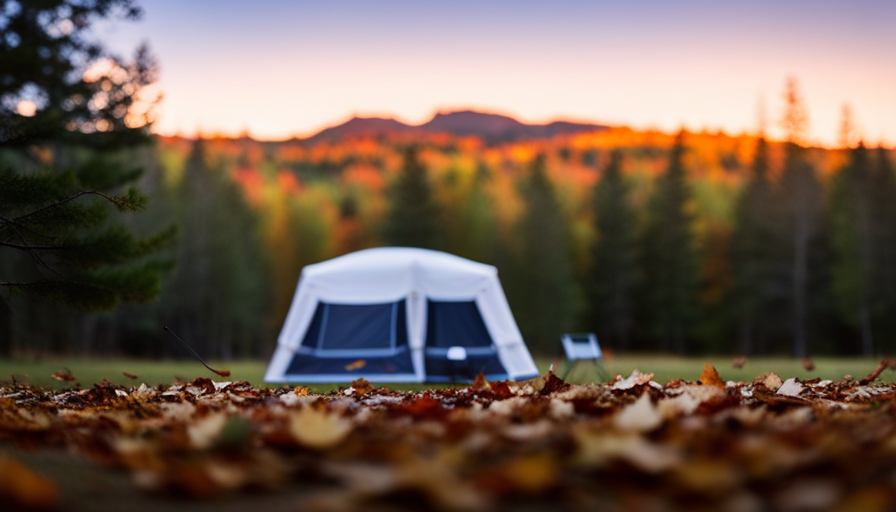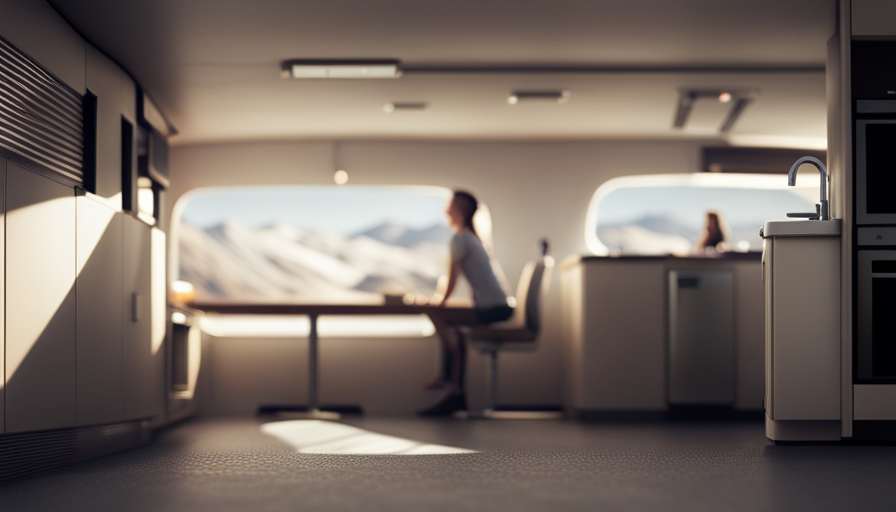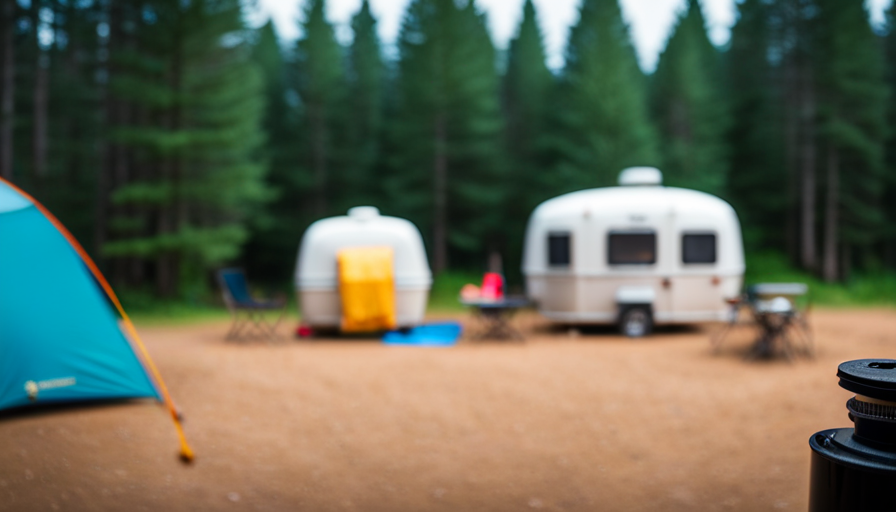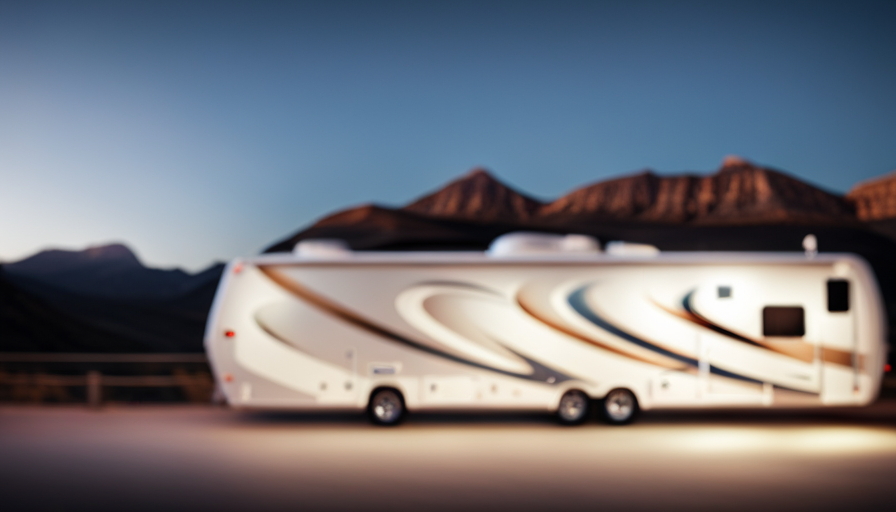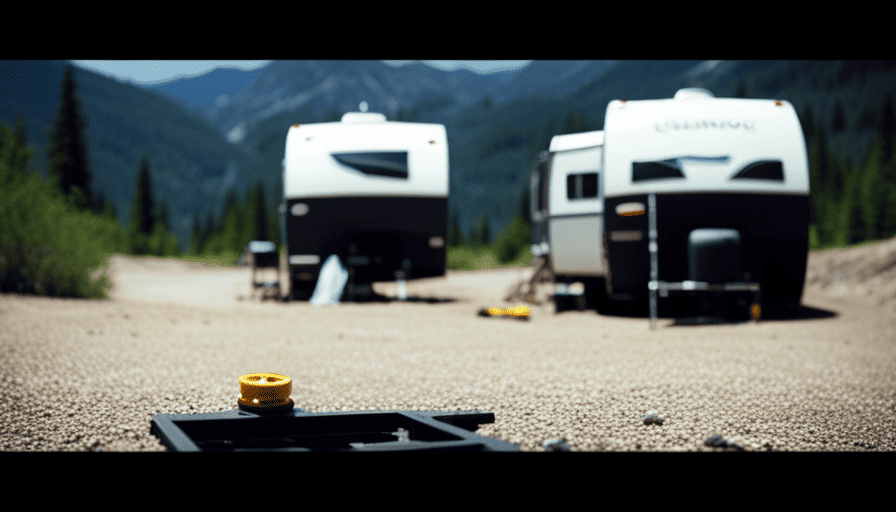Have you ever encountered the devastating sensation of finding your cherished camper harmed by the winter conditions? It’s a situation no owner of a camper desires to confront. This is why understanding the right time to winterize your camper is essential in safeguarding it against severe weather.
In this article, we will delve into the technical details of winterizing your camper, ensuring its longevity for many seasons to come.
As the temperature drops and freezing conditions loom, it’s essential to take proactive measures to safeguard your camper. By understanding the importance of winterization, checking weather forecasts, and considering your camper’s specific needs, you can prevent costly damage and extend its lifespan.
We will guide you through the process of preparing the water system, insulating and sealing your camper, and properly storing it during the winter months. Additionally, we will emphasize the significance of regular maintenance and inspection to ensure your camper remains in optimal condition.
Don’t let winter catch you off guard. Join us as we explore the ins and outs of winterizing your camper, equipping you with the knowledge and skills to protect your investment.
Key Takeaways
- Winterizing your camper is crucial to protect it from winter weather and extend its lifespan.
- Different campers may have different winterization needs based on their construction.
- Prepare the water system by adding antifreeze to the tanks and insulating exposed pipes.
- Regular maintenance and inspection are important to keep your camper in optimal condition.
Understanding the Importance of Winterizing Your Camper
Before you hit the road for your next adventure, make sure you understand the importance of winterizing your camper to avoid any costly repairs or damage.
Winterizing your camper is crucial in preventing frozen pipes and protecting the exterior from harsh winter conditions.
One of the main reasons to winterize your camper is to prevent frozen pipes. When water freezes, it expands, which can cause pipes to burst and lead to costly repairs. By properly winterizing your camper, you can ensure that all water is drained from the pipes, preventing any potential damage.
In addition to preventing frozen pipes, winterizing your camper also helps protect the exterior. Harsh winter weather, such as snow, ice, and freezing temperatures, can cause damage to the exterior of your camper. By applying a protective coating or covering to your camper, you can shield it from these elements and extend its lifespan.
Before you start the process of winterizing your camper, it’s important to check the weather forecast for freezing temperatures. This will help you determine the urgency of winterizing and prioritize the tasks accordingly.
By staying proactive and taking the necessary steps to winterize your camper, you can ensure that it remains in good condition and ready for your next adventure.
Checking the Weather Forecast for Freezing Temperatures
As you plan your next adventure, make sure to check the weather forecast for any freezing temperatures that could potentially impact your trip. Checking local climate conditions is crucial in determining whether or not to winterize your camper.
Freezing temperatures can cause significant damage to your camper’s plumbing system, water lines, and tanks if not properly prepared. To protect your camper from freezing temperatures, you can consider using a camper cover. A camper cover provides an extra layer of insulation and protection against cold weather elements. It helps to prevent frost from forming on your camper’s surfaces and reduces the risk of damage caused by freezing temperatures.
Before applying the camper cover, it’s important to ensure that your camper is properly winterized. This includes draining all water from the plumbing system, water lines, and tanks. Additionally, you should remove any residual water from the water heater and toilets. Failure to complete these steps can result in frozen and burst pipes, leading to costly repairs.
Considering the type of camper and its specific winterization needs is essential. Different campers may have varying requirements for winterization, depending on their construction and features. Understanding these specific needs will help you take the necessary steps to protect your camper from potential damage during freezing temperatures.
Considering the Type of Camper and Its Specific Winterization Needs
To properly protect your adventure companion from freezing temperatures, take into consideration the specific needs of your camper and its construction. Different types of campers may require different insulating methods and winterization techniques. Here are three key factors to consider when winterizing your camper:
-
Construction Materials: The materials used in your camper’s construction will determine its insulation capabilities. Campers made with high-quality materials like fiberglass or aluminum tend to have better insulation properties than those made with cheaper materials. Insulating the walls, windows, and doors can help retain heat and prevent cold air from seeping in.
-
Heating System: Some campers come with built-in heating systems, while others rely on portable heaters. It’s important to ensure that your camper’s heating system is in good working condition before winter hits. Check for any leaks or malfunctions and have them repaired if necessary. Additionally, consider using insulation blankets or heat pads to further protect your camper from freezing temperatures.
-
Winterizing Checklist: Create a comprehensive winterizing checklist that includes tasks such as draining water tanks, disconnecting and storing hoses, and adding antifreeze to the plumbing system. Following a checklist will help ensure that you don’t miss any important steps in preparing your camper for winter.
By considering the insulation needs of your camper and following a winterizing checklist, you can safeguard your adventure companion from the harsh winter weather. Now, let’s move on to preparing the water system for winter without delay.
Preparing the Water System for Winter
When it comes to protecting your adventure companion from freezing temperatures, you’ll want to pay special attention to preparing the water system for winter. Did you know that nearly 90% of water system damage in campers occurs during the winter months?
To prevent freezing and ensure a smooth camping experience, it’s crucial to treat the water tanks properly. Start by adding antifreeze specifically designed for RV water systems to the tanks. This will help prevent the water from freezing and damaging the tanks. Additionally, make sure to insulate any exposed pipes or hoses to further safeguard against freezing temperatures.
To treat the water tanks effectively, it’s important to follow the manufacturer’s instructions for the specific antifreeze product being used. Usually, this involves pouring the antifreeze into the tanks and then running the water pump to circulate the antifreeze throughout the system. This step ensures that all parts of the water system are protected from freezing.
Preparing the water system for winter is a crucial step in winterizing your camper. Treating water tanks with antifreeze and insulating exposed pipes will prevent freezing and potential damage.
Now that we’ve covered preparing the water system, let’s move on to the next step of draining and flushing the water tanks.
Draining and Flushing the Water Tanks
Now let’s tackle the important task of getting those water tanks drained and flushed to keep your adventure companion in tip-top shape. Flushing your water tanks is a crucial step in winterizing your camper because it helps prevent water damage and ensures that your plumbing system stays in optimal condition during the cold months.
To begin, start by turning off the water supply and opening all the faucets to release any pressure. Next, locate the drain valves for both the fresh water tank and the gray water tank. Attach a hose to the valve of each tank and position the other end where you want the water to drain. Open the valves and let the water flow out completely.
Once the tanks are drained, it’s time to flush them. Fill the fresh water tank with a cleaning solution recommended for RV water systems. Then, turn on the water pump and open each faucet, one at a time, until you smell the cleaning solution. Let it sit for a few minutes to dissolve any built-up residue. After that, drain the tanks again, making sure to flush out all the cleaning solution.
With the water tanks drained and flushed, you can now move on to treating and protecting the plumbing system. This step will ensure that your camper is fully prepared for the winter season and will help prevent any potential damage.
Treating and Protecting the Plumbing System
Once you’ve got those water tanks drained and flushed, it’s time to show some love to your plumbing system and make sure it’s ready to withstand the winter chill. Treating and protecting the plumbing is crucial to prevent any damage caused by freezing temperatures.
Here’s what you need to do:
-
Use RV antifreeze: Pour RV antifreeze into the drains, toilet, and tanks to help prevent any remaining water from freezing and causing cracks or burst pipes. Make sure to follow the manufacturer’s instructions for the correct amount to use.
-
Insulate exposed pipes: Identify any exposed plumbing pipes and insulate them with foam pipe insulation. This will provide an extra layer of protection against the cold and help prevent freezing.
-
Seal any gaps or leaks: Check for any gaps or leaks in the plumbing system and seal them using silicone caulk or pipe sealant. This will help prevent cold air from entering and causing pipes to freeze.
-
Disconnect and drain outdoor hoses: Disconnect any outdoor hoses and drain them completely. Store them in a warm and dry place to prevent freezing and damage.
Treating and protecting the plumbing system is an essential part of winterizing your camper. Once you’ve completed these steps, it’s time to move on to insulating and sealing the camper for cold weather. This ensures that your camper stays warm and protected throughout the winter season.
Insulating and Sealing the Camper for Cold Weather
To keep your vehicle cozy during colder months, it’s important to insulate and seal it properly. Insulating techniques for campers vary but commonly include adding insulation to the walls, floor, and ceiling. This helps to prevent heat loss and maintain a comfortable temperature inside.
One effective method is to use foam board insulation, which is lightweight and easy to install. It can be cut to fit the walls and secured with adhesive or tape. Additionally, insulating curtains or thermal window coverings can be used to reduce heat transfer through the windows.
Sealing methods are equally important in keeping the cold air out and the warm air in. Start by checking for any gaps or cracks around windows, doors, vents, and utility hookups. These can be sealed with weatherstripping or caulk. Pay special attention to areas where pipes or cables enter the camper, as they can be potential entry points for cold air. Another sealing technique is to use insulation tape to seal any gaps or seams in the camper’s exterior.
By insulating and sealing your camper properly, you can create a cozy and warm environment even during the coldest winter months.
Now, let’s move on to the next section about removing and storing valuables and perishables.
Removing and Storing Valuables and Perishables
It’s important to safely remove and store valuable items and perishable goods before the cold weather sets in, ensuring that they’re protected and preserved. Here are five essential steps to follow when storing electronics and preventing mold growth:
-
Safely remove all electronics from the camper, including TVs, radios, and laptops. These items are sensitive to extreme temperatures and can be damaged if left inside during the winter months.
-
Wrap each electronic device in a soft cloth or bubble wrap to provide extra protection against any potential impact or moisture.
-
Store the electronics in a dry and climate-controlled area. This’ll prevent any moisture or condensation from damaging the devices and reduce the risk of mold growth.
-
Use silica gel packets or moisture absorbers to further prevent moisture buildup. Place them near the stored electronics to absorb any excess humidity in the air.
-
Regularly check the stored electronics throughout the winter to ensure their condition. If any signs of moisture or mold growth are detected, take immediate action to address the issue.
Properly storing the camper to prevent damage is the next crucial step in winterizing your camper.
Properly Storing the Camper to Prevent Damage
Storing the camper correctly is essential to protect it from potential damage during the winter months. One important aspect of proper storage is preventing rodent infestation. Rodents can cause significant damage to the interior of the camper by chewing through wires, upholstery, and insulation. To prevent this, it’s recommended to thoroughly clean the camper before storage, removing any food crumbs or traces that may attract rodents.
Additionally, placing rodent repellent sachets or traps inside the camper can help deter them from entering.
Choosing a suitable storage location is also crucial. Ideally, the camper should be stored in a dry and well-ventilated area to prevent moisture buildup, which can lead to mold and mildew growth. If possible, consider storing the camper in a covered or indoor facility to provide additional protection from the elements. Before storing, make sure to properly secure all windows, doors, and vents to prevent water leakage.
Properly storing the camper is essential to prevent potential damage during the winter months. By taking measures to prevent rodent infestation and choosing a suitable storage location, you can ensure that your camper remains in good condition.
In the next section, we’ll discuss the importance of regular maintenance and inspection during winter storage.
Regular Maintenance and Inspection During Winter Storage
Make sure you regularly inspect and maintain your camper during winter storage to avoid any potential damage. Regular maintenance is crucial to keep your camper in good condition and prevent any issues that may arise during the winter months.
Here are some important steps to consider when performing maintenance and inspection during winter storage.
First, check the exterior of your camper for any signs of damage or wear. Look for cracks in the roof, windows, and doors, as well as any loose or missing screws or fasteners. Repair or replace any damaged parts to ensure a watertight seal and prevent moisture from entering the camper.
Next, inspect the interior of the camper for any signs of pests or mold. Clean all surfaces thoroughly and check for any signs of water leaks. Pay special attention to the plumbing system and ensure that all pipes are properly drained and winterized.
Additionally, it’s important to maintain the battery and electrical system during winter storage. Keep the battery charged and periodically check for any signs of corrosion. Disconnect the battery if it’s not in use to prevent any drain or damage.
Perform routine maintenance tasks such as lubricating hinges and locks, checking and topping off fluids, and inspecting the tires for proper inflation and wear.
By following these regular maintenance steps during winter storage, you can ensure that your camper stays in optimal condition and is ready for your next adventure.
Frequently Asked Questions
Can I still use my camper during the winter if I don’t winterize it?
No, it’s not recommended to use your camper during the winter if you don’t winterize it. Failure to winterize your camper can result in potential damage. Cold temperatures can cause water pipes to freeze and burst, leading to costly repairs. Additionally, without proper winterization, the plumbing and water systems may be compromised, leading to leaks and further damage.
It’s essential to winterize your camper to protect its integrity and ensure its longevity.
How long does it take to winterize a camper?
Winterizing a camper quickly is crucial to protect it from the harsh winter elements. It typically takes around 1-2 hours to complete the process.
To begin, drain all water from the system, including the tanks and lines. Next, add antifreeze to prevent any remaining water from freezing and causing damage. Be sure to check for common mistakes like forgetting to disconnect the battery or not properly sealing vents.
By following these steps, you can efficiently winterize your camper and ensure its longevity.
Can I use antifreeze from my local hardware store to winterize my camper?
Yes, you can use antifreeze from your local hardware store to winterize your camper. However, it’s important to note that using improper antifreeze can have negative effects on your camper. It’s recommended to use antifreeze specifically designed for RVs, as it contains additives to protect the plumbing system.
Using alternative methods for winterizing campers can lead to costly repairs due to frozen pipes or damaged seals. It’s best to follow the manufacturer’s recommendations for winterizing your camper.
Do I need to remove all the water from my camper’s plumbing system?
To properly winterize your camper’s plumbing system, it’s crucial to remove all the water. One effective method is using compressed air. By connecting an air compressor to the water lines, the air pressure will force out any remaining water.
Alternatively, you can also use antifreeze to displace the water. However, it’s important to note that antifreeze should never be used in the fresh water tank or the lines connected to it.
Can I leave my camper outside during the winter if it’s properly winterized?
Yes, you can leave your winterized camper outside during the winter, as long as it’s properly covered. Using a cover for your winterized camper has several advantages. It helps protect your camper from harsh weather conditions, such as snow, ice, and rain. It also prevents any potential damage to the exterior and interior of your camper.
However, it’s important to note that leaving your camper outside for an extended period may still have some disadvantages, such as increased exposure to the elements and potential theft or vandalism.
Should I Store My Camper Before or After Winterizing It?
When deciding whether to store your camper before or after winterizing it, it’s important to consider the available camper storage options. Storing it before winterizing allows for immediate protection, while storing it after winterizing ensures your camper is in optimal condition once spring arrives. Choose the option that suits your needs and preserves your investment.
Conclusion
In conclusion, winterizing your camper is crucial to protect it from the harsh elements of winter. By checking the weather forecast for freezing temperatures and considering the specific winterization needs of your camper, you can ensure its longevity.
Preparing the water system, insulating and sealing the camper, and removing valuables and perishables are all important steps to take. Properly storing the camper and conducting regular maintenance and inspection during winter storage are also essential.
Remember, just like a cozy cabin tucked away in a snowy landscape, a well-winterized camper will be a safe haven for your adventures to come.

